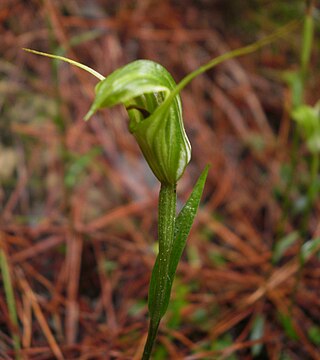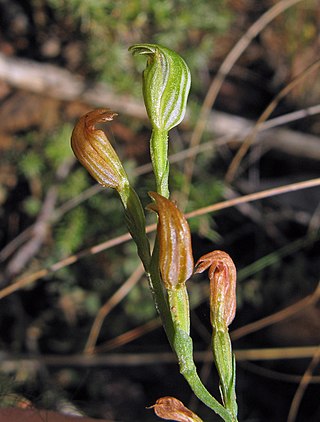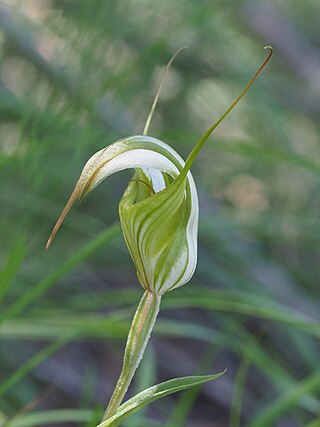
Pterostylis coccina, commonly known as the scarlet greenhood, is a species of orchid endemic to eastern Australia. As with similar greenhoods, the flowering plants differ from those which are not flowering. The non-flowering plants have a rosette of leaves flat on the ground but the flowering plants have a single flower with leaves on the flowering spike. In this species, the rosette leaves are relatively large and dark green, and the flowers are white, and bluish-green or red. It grows in New South Wales and north-eastern Victoria.

Pterostylis grandiflora, commonly known as the cobra greenhood or superb greenhood, is a species of orchid endemic to south-eastern Australia. As with similar orchids, the flowering plants differ from those which are not flowering. The non-flowering plants have a rosette of leaves but the flowering plants lack a rosette and have a single flower with leaves on the flowering spike. This greenhood has a green and white, striped flower with deep red-brown markings especially on its "galea", and a sharply pointed dorsal sepal.

Pterostylis baptistii, commonly known as the king greenhood, is a species of orchid endemic to eastern Australia. Flowering plants have a rosette of stalked, dark green leaves and a single white flower with green and brown markings, and a wide gap between the petals and lateral sepals. It occurs mostly in New South Wales but is also found in coastal Queensland and north-eastern Victoria.

Pterostylis trullifolia, commonly known as the trowel-leaved greenhood, is an orchid species endemic to New Zealand. As with similar orchids, the flowering plants differ from those which are not flowering. The non-flowering plants have a rosette of wrinkled, trowel-shaped leaves but the flowering plants have a single flower with a bulging, platform-like sinus between the lateral sepals and leaves on the flowering spike.

Pterostylis fischii, commonly known as Fisch's greenhood, is a species of orchid endemic to south-eastern Australia. As with similar greenhoods, the flowering plants differ from those which are not flowering. The non-flowering plants have a rosette of leaves flat on the ground but the flowering plants have a single flower with leaves on the flowering spike. This greenhood has tawny-coloured flowers, a dorsal sepal with a long thread-like tip and a labellum which is hidden inside the flower.

Pterostylis atrans, commonly known as the dark-tip greenhood or blunt-tongue greenhood, is a species of orchid endemic to south-eastern Australia. As with similar greenhoods, plants in flower differ from those that are not flowering. The non-flowering plants have a rosette of leaves flat on the ground, but the plants in flower have a single flower with leaves on the flowering spike. In this species, the flower is green and reddish brown with a protruding sinus and small club-like tips on the ends of the lateral sepals.

Pterostylis hamiltonii, commonly known as the red-veined shell orchid, is a species of orchid endemic to the south-west of Western Australia. As with similar orchids, the flowering plants differ from those which are not flowering. The non-flowering plants have a rosette of leaves but the flowering plants lack a rosette and have a single flower with leaves on the flowering spike. This greenhood has a green and white, striped flower with reddish-brown markings and forms colonies, sometimes of thousands of plants.

Pterostylis parviflora, commonly known as the tiny greenhood, is a species of orchid endemic to south-eastern Australia. As with similar orchids, the flowering plants differ from those which are not flowering. The non-flowering plants have a rosette of leaves but the flowering plants lack a rosette at the base but have up to eight tiny green, white and brown flowers.

Pterostylis pedoglossa, commonly known as the prawn greenhood, is a species of orchid endemic to south-eastern Australia. There is a rosette of leaves at the base and flowering plants have a single white flower with green stripes, sometimes with a brownish tinge on the tip, and a long, thread-like labellum.

Pterostylis revoluta, commonly known as the autumn greenhood, is a species of orchid endemic to south-eastern Australia. As with similar greenhoods, the flowering plants differ from those which are not flowering. The non-flowering plants have a rosette of leaves flat on the ground but the flowering plants have a single flower with leaves on the flowering spike. This greenhood has white and green flowers that have a long, curved, pointed labellum which extends beyond the sinus between the lateral sepals.

Pterostylis tenuissima, commonly known as the swamp greenhood, is a species of orchid endemic to the southern mainland of Australia. As with similar greenhoods, the flowering plants differ from those which are not flowering. The non-flowering plants have a rosette of leaves flat on the ground but the flowering plants have a single flower with leaves on the flowering spike. This greenhood has small translucent white flowers with dark green stripes and markings and both the dorsal sepal and lateral sepals have relatively long, thread-like tips.

Pterostylis laxa, commonly known as the antelope greenhood, is a species of orchid endemic to south-eastern Australia. As with similar greenhoods, the flowering plants differ from those which are not flowering. The non-flowering plants have a rosette of leaves flat on the ground but the flowering plants have a single flower with leaves on the flowering spike. This greenhood has green and white flowers with darker green or brown markings and a dorsal sepal with a long thread-like tip.

Pterostylis longipetala, commonly known as the curved greenhood, is a species of orchid endemic to eastern Australia. As with similar greenhoods, the flowering plants differ from those which are not flowering. The non-flowering plants have a rosette of leaves flat on the ground but the flowering plants have a single flower with leaves on the flowering spike. This greenhood has dark green, brown and white flowers which lean slightly forwards and have sharply-pointed petals and a long, curved labellum.
Pterostylis alata, commonly known as striped greenhood, is a species of orchid endemic to Tasmania. As with similar orchids, the flowering plants differ from those which are not flowering. The non-flowering plants have a rosette of leaves but the flowering plants have a single flower with leaves on the flowering spike. This greenhood has a white flower with prominent dark green stripes and a sharply pointed, brown-tipped dorsal sepal. Similar greenhoods growing on the Australian mainland were formerly known as Pterostylis alata but are now given the name Pterostylis striata.

Pterostylis striata, commonly known as the mainland striped greenhood, is a species of orchid endemic to south-eastern mainland Australia. As with similar orchids, the flowering plants differ from those which are not flowering. The non-flowering plants have a rosette of leaves but the flowering plants have a single flower with leaves on the flowering spike. This greenhood has a white flower with prominent dark green stripes and a brown-tipped dorsal sepal with a thread-like tip. Mainland striped greenhoods were formerly described as Pterostylis alata but that species is now recognised as a Tasmanian endemic.
Pterostylis aquilonia, commonly known as the northern cobra greenhood, is a species of orchid endemic to Queensland. As with similar orchids, the flowering plants differ from those which are not flowering. The non-flowering plants have a rosette of leaves, but the flowering plants lack a rosette and have a single flower with leaves on the flowering spike. This greenhood has a relatively large green, white and reddish-brown self-pollinating flower.

Pterostylis hildae, commonly known as the rainforest greenhood, is a species of orchid found in eastern Australia. It has a rosette of leaves and when flowering a rosette at the base of a flowering stem with a single green, white and brown flower. It is found in wet forests, including rainforest in New South Wales and Queensland.

Pterostylis reflexa, commonly known as the dainty greenhood, is a species of orchid endemic to New South Wales. As with similar greenhoods, the flowering plants differ from those which are not flowering. The non-flowering plants have a rosette of leaves flat on the ground but the flowering plants have a single flower with leaves on the flowering stem. This greenhood has a relatively large white, green and light brown flower with a long, curved dorsal sepal and a protruding labellum.
Pterostylis rogersii, commonly known as the curled-tongue shell orchid, is a species of orchid endemic to the south-west of Western Australia. As with similar orchids, the flowering plants differ from those which are not flowering. The non-flowering plants have a rosette of leaves but the flowering plants lack a rosette and have a single flower with leaves on the flowering spike. This greenhood usually has a white and reddish-brown striped flower with a long, curved labellum and is found along the south coast between Binningup and Esperance.

Pterostylis russellii, commonly known as Russell's greenhood, is a species of orchid endemic to eastern Australia. Non-flowering plants have a rosette of leaves flat on the ground but flowering plants have a single shiny white and dark green flower on a flowering stem lacking a rosette but with a few spreading stem leaves.

















